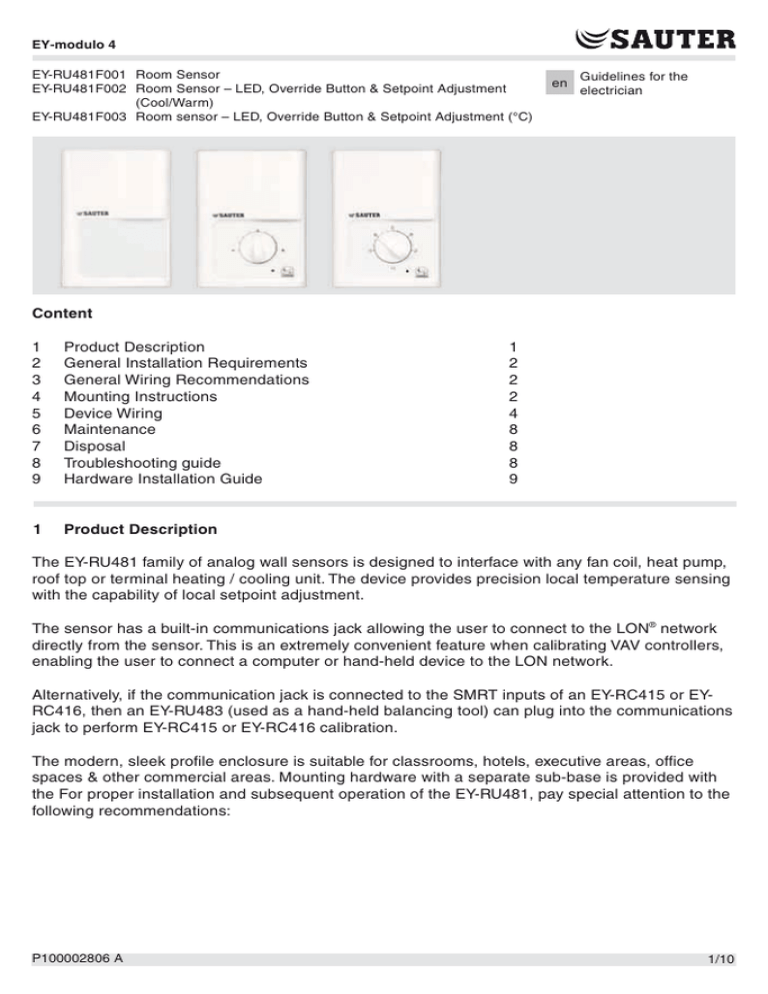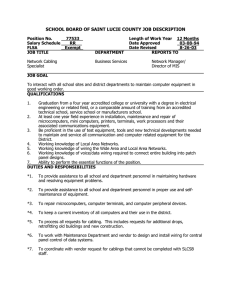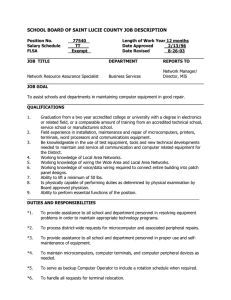Product Description 1 The EY-RU481 family of analog wall sensors
advertisement

EY-modulo 4 EY-RU481F001 Room Sensor EY-RU481F002 Room Sensor – LED, Override Button & Setpoint Adjustment (Cool/Warm) EY-RU481F003 Room sensor – LED, Override Button & Setpoint Adjustment (°C) en Guidelines for the electrician Content 1 2 3 4 5 6 7 8 9 Product Description General Installation Requirements General Wiring Recommendations Mounting Instructions Device Wiring Maintenance Disposal Troubleshooting guide Hardware Installation Guide 1 Product Description 1 2 2 2 4 8 8 8 9 The EY-RU481 family of analog wall sensors is designed to interface with any fan coil, heat pump, roof top or terminal heating / cooling unit. The device provides precision local temperature sensing with the capability of local setpoint adjustment. The sensor has a built-in communications jack allowing the user to connect to the LON® network directly from the sensor. This is an extremely convenient feature when calibrating VAV controllers, enabling the user to connect a computer or hand-held device to the LON network. Alternatively, if the communication jack is connected to the SMRT inputs of an EY-RC415 or EYRC416, then an EY-RU483 (used as a hand-held balancing tool) can plug into the communications jack to perform EY-RC415 or EY-RC416 calibration. The modern, sleek profile enclosure is suitable for classrooms, hotels, executive areas, office spaces & other commercial areas. Mounting hardware with a separate sub-base is provided with the For proper installation and subsequent operation of the EY-RU481, pay special attention to the following recommendations: P100002806 A 1/10 2 General Installation Requirements • Upon unpacking the product, inspect the contents of the carton for shipping damages. Do not install damaged devices. • Allow for proper clearance of device enclosure and wiring terminals for easy access, hardware configuration and maintenance. • The device is designed to operate under the following environmental conditions: • Ambient temperature from 0°C to 70°C • Relative humidity from 0% to 95%, non-condensing. • Ensure proper ventilation of device and avoid areas where corroding, deteriorating or explosive vapors, fumes or gases may be present. The device must be oriented with the ventilation slots towards the top to permit proper heat dissipation. • device for installation on dry wall or on a electrical junction box. This document describes the hardware installation procedures for the following devices: EYRU481F001, EY-RU481F002 and EY-RU481F003. Unless otherwise indicated, the term EY-RU481 will be used in this document to represent all models of the EY-RU481 family. Take reasonable precautions to prevent electrostatic discharges to the device when installing, servicing or operating the device. Discharge accumulated static electricity by touching one’s hand to a securely grounded object before working with this device. 3 General Wiring Recommendations WARNING Danger of electrocution ffTurn off power before any kind of servicing. • All wiring must comply with electrical wiring diagrams as well as national and local electrical codes. • To connect the wiring to the device, use the terminal connectors which are located inside the device’s enclosure. Use a small flat screwdriver to tighten the terminal connector screws once the wires have been inserted. • The board connectors accept wires or flat cables ranging from 22 to 14 AWG (0.644-1.630mm diameter) per pole. • It is recommended that all terminals be wired by 18AWG wire except for LON communications. 4 Mounting Instructions The EY-RU481 has been specially designed for easy installation. However, certain conditions apply when choosing a suitable location for the device: • The device should not be installed on an exterior wall. • The device should not be installed near a heat source. • The device should not be installed near an air discharge grill. • The device should not be installed in a place were it can be affected by the sun. • Install the device in an area that provides proper device ventilation. Nothing must restrain air circulation to the device. 2/10 P100002806 A NOTICE 4.1 The EY-RU481 has not been designed for outdoor use. Installation procedure 1. Remove the security screw from the device (Figure 1). 2. Open the device by pressing in the two (2) tabs on the bottom of the device and pulling the bottom side of the front plate outwards. 3. Flip the printed circuit board over to access the mounting hole. 4. Pull all cables 6” out of the wall, and insert them through the central hole of the back plate. 5. Align the back plate with the wall and mark the location of the two mounting holes on the wall. Make sure to orient the proper side of the back plate facing upwards. 6. Remove the back plate and drill holes in the wall if necessary. 7. Install anchors in the wall if necessary. 8. Make sure that the mounting surface is flat and clean. 9. Screw the back plate onto the wall. Do not over tighten. 10. Strip each wire 6 mm and insert each one according to the wiring diagrams shown in this document. 11. Gently push excess wiring back into the wall. 12. Flip the printed circuit board back into place. 13. Reattach the front plate and make sure it clips tightly into place. 14. Install security screw. P100002806 A 3/10 1 1 2 4 B11648 3 Fig. 1 Mounting an EY-RU481 controller 1 2 3 4 5 Wall Anchors Pull on Plastic tab to release the printes circuit board Flip printed circuit board to access mounting hole Security Srew Device Wiring The EY-RU481 has physical connections for up to four different features depending on the model. The following table identifies how the EY-RU481‘s terminals are used: EY-RU481 Feature Associated Terminals Thermistor 1&2 Averaging Thermistor 2&3 Setpoint Potentiometer 3&4 LED 5&6 Communications Jack Communications Terminals (1 & 2) Fig. 2 10kΩ Setpoint potentiometer input 4/10 P100002806 A 1 2 3 4 5 6 Fig. 4 Terminal description 5.1 1 2 B11611 1/8" Com. Jack Fig. 3 EY-RU481 wiring terminals Wiring a 10kΩ Thermistor Controller + - Internal NTC Thermistor 10kW 1 Internal Override Button 2 Fig. 5 10kΩ NTC Thermistor input P100002806 A B11612 Terminals 1 and 2 are used for the 10kΩ type 2 NTC thermistor, as well as for the override button (not available on EY-RU481F001 model). These terminals are present on every EYRU481 model. 5/10 The override button creates a short circuit on the controller input, which is interpreted as an override signal. 5.2 Wiring a 10kΩ Setpoint Potentiometer Controller + - 3 4 Internal Potentiometer 10k B11613 Terminals 3 and 4 are used for the 10kΩ setpoint potentiometer. Fig. 6 10kΩ Setpoint potentiometer input If both the 10kΩ type 2 NTC thermistor and 10kΩ setpoint potentiometer are being wired to the same controller, only three wires are required. Connect terminal 2 to terminal 3. Internal NTC Thermistor 10k Internal Override Button 1 2 3 4 Internal Potentiometer 10k B11614 Controller + + Fig. 7 10kΩ NTC Thermistor and setpoint potentiometer inputs 5.3 Wiring a Status LED indicator Controller + - 5 6 Internal LED B11615 Terminals 5 and 6 are used to connect a controller output to the status LED indicator. Fig. 8 Status LED indicator input 5.4 Wiring EY-RU483 room unit to a VAV for VAV Balancing The EY-RU483 room unit can be used as a hand-held device to perform VAV balancing. The communications terminals (1 and 2) within the EY-RU481 must be connected to the SMRT+ and SMRT-inputs of the VAV before the communications jack can be used. To wire an EY-RU483 room unit to a VAV via an EY-RU481 do the following: 1. Remove the front plate of the EY-RU481 2. Connect the communications terminals (1 and 2) to the SMRT+ and SMRT-terminals of the VAV controller. 3. Remove the front plate of the EY-RU483 room unit. 4. Connect the two (2) wires that terminate with the 1/8“ audio cable to the T1 and T2 output terminals of the EY-RU483 room unit. 6/10 P100002806 A 5. Insert the 1/8“ audio cable into the communications jack of the EY-RU481. VAV Controller SMRTSMRT+ EC-Sensor 2 1 1/8" Com. Jack SMRT B11616 Smart-Sensor Fig. 9 Wiring Smart-Sensor to a VAV for VAV balancing 5.5 Wiring an EY-RU481 to a LON Network for Technician Use The communications terminals (1 and 2) within the EY-RU481 can be optionally wired to the LON terminals of a controller. If inserting multiple wires in the terminals, ensure to properly twist wires together prior to inserting them in the terminal connectors. A laptop can then access the LON network by plugging into the EY-RU481’s communications jack with a 1/8“ audio cable at any time. To wire a computer to the LON network via an EY-RU481, do the following: 1. Remove the front plate of the EY-RU481. 2. Connect the communication terminals (1 and 2) of the EY-RU481 to the LON1 and LON2 input terminals on the controller. 3. Connect the two (2) wires that terminate with the 1/8“ audio cable to the output terminals of the PCLTA card on the computer (other methods of connecting to the computer are possible). 4. Insert the 1/8“ audio cable into the communications jack of the EY-RU481. P100002806 A 7/10 Controller LON2 LON1 EC-Sensor 2 1 1/8" Com. Jack LON B11617 Computer Fig. 10 Wiring EC-Sensor to a LON network for technician use The recommended cable type for LON communications is 22AWG (0.65mm), twisted pair, unshielded. The LON communication wire is polarity insensitive and can be laid out in a bus, star, loop or free topology. For loop topology, polarity is important, special care must be taken when connecting the LON network to avoid short circuit. For more information and detailed explanations on network topology and wire length restrictions, please refer to the Junction Box and Wiring Guideline for Twisted Pair LonWorks® Networks, published by Echelon ® Corporation. 6 Maintenance WARNING Danger of electrocution ffTurn off power before any kind of servicing. Each controller requires minimal maintenance, but it is important to take note of the following: • If it is necessary to clean the outside of the front plate and/or the inside of the back plate, use a dry cloth. • Verify the tension of all wires and cables whenever the controller is serviced. 7 Disposal Products must be disposed of at the end of their useful life according to local regulations. 8/10 P100002806 A 8 Troubleshooting guide Device communicates well over a short network, but does not communicate on large network Network length Check that the total wire length does not exceed the specifications of the Junction Box and Wiring Guideline for Twisted Pair LonWorks Networks. Wire type Check that the wire type agrees with the specification of the Junction Box and Wiring Guideline for Twisted Pair LonWorks Networks. Network wiring problem Double check that the wire connections are correct. Absent or incorrect network termination Check the termination(s). Incorrect or broken termination(s) will make the communication integrity dependent upon a device’s position on the network. Extra capacitance Make sure that no extra capacitance is being connected to the network other than the standard FTT circuit and that there is a maximum stub length of 10ft (3m) in bus topology. Number of devices on network segment exceeded The number of devices on a channel should never exceed 64. Use a router or a repeater in accordance to the Junction Box and Wiring Guideline for Twisted Pair LonWorks Networks. Network traffic Query node statistic to check errors. Use a LON protocol analyzer to check network traffic. Hardware input is not reading the correct value Input wiring problem Check that the wiring is correct according to this manual and according to the peripheral device’s manufacturer. Open circuit or short circuit Using a voltmeter, check the voltage on the input terminal. Short circuit (0V) and open circuit (5V). Configuration problem Refer to the device’s user guide for more information. Hardware output is not operating correctly Output wiring problem Check that the wiring is correct according to this manual and according to the peripheral device’s manufacturer. Configuration problem Refer to the device’s user guide for more information. P100002806 A 9/10 9 Hardware Installation Guide While all efforts have been made to verify the accuracy of information in this manual, SAUTER is not responsible for damages or claims arising from the use of this manual. Persons using this^manual are assumed to be trained HVAC specialist / installers and are responsible for using the correct wiring procedures and maintaining safe working conditions with fail-safe environments. SAUTER reserves the right to change, delete or add to the information in this manual at any time without notice. © Fr. Sauter AG Im Surinam 55 CH-4016 Basel Tel. +41 61 - 695 55 55 Fax +41 61 - 695 55 10 www.sauter-controls.com info@sauter-controls.com 10/10 Printed in Switzerland Echelon, Neuron, LON, LONWORKS, LONMARK and LNS are registered trademarks of Echelon P100002806 A

